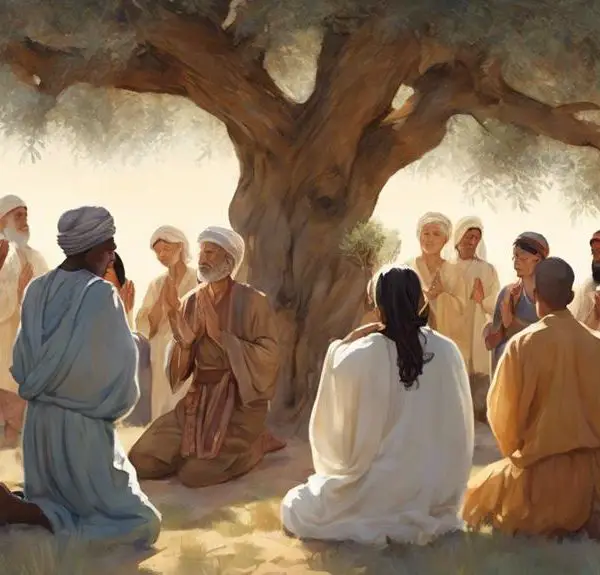Navigate tales of doubt and disbelief woven through biblical stories, revealing the nuanced relationship between faith and skepticism.

Examples of Unbelief in the Bible
You'd think the Bible was brimming with faith so strong it could move mountains at a whisper, yet it's also a rich tapestry of doubt and disbelief.
From Thomas, who demanded proof of resurrection, to Sarah's incredulous laughter at the promise of a child, these stories are not just ancient history; they're mirrors reflecting our own moments of skepticism.
Consider Moses, who hesitated before Pharaoh, or the Israelites, whose faith wavered in the desert. Even Peter, a cornerstone of faith, faltered in his moment of truth.
These narratives invite you to explore the complexity of belief, challenging you to confront your own doubts and perhaps find a deeper understanding of faith's true essence.
Key Takeaways
- Unbelief in the Bible often leads to a deeper, more profound faith.
- Skepticism is met with divine patience and evidence to restore faith.
- Doubts and fears reflect common human frailty, even among biblical figures.
- Divine responses to skepticism underscore the importance of trust in spiritual growth.
The Doubt of Thomas

The Doubt of Thomas provides a compelling narrative on skepticism within the Christian faith, illustrating how even the closest followers of Jesus wrestled with unbelief. This story serves as a critical examination of faith restoration and underscores skepticism's role in the journey towards belief.
Thomas, often labeled as the 'doubter,' sought empirical evidence of Jesus' resurrection, expressing a desire to see and touch Jesus' wounds before believing in His return from the dead. This incident not only highlights human tendencies towards skepticism but also emphasizes the patience and accommodative nature of faith itself.
Analyzing this passage, one observes that skepticism isn't condemned outright but is portrayed as a step towards achieving a deeper, more resilient faith. Jesus' response to Thomas, rather than reprimanding, facilitates faith restoration by providing the sought-after evidence, thereby transforming doubt into conviction. This interaction suggests that experiencing skepticism isn't tantamount to a lack of faith but is part of the process through which faith becomes more personalized and fortified.
The Doubt of Thomas thus serves as a reassurance that faith can emerge stronger from the crucible of skepticism, offering a profound lesson on the dynamics of belief and doubt within the Christian tradition.
Sarah's Laughter

In the narrative of Sarah's laughter, skepticism emerges not from a stranger to faith but from its very heart, as Sarah herself struggles with the promise of bearing a child in her advanced age. This moment, rich in human emotion and divine interaction, reveals the complexity of belief and the nuances of faith's challenges. Sarah's surprise upon hearing the prophecy is a natural human reaction, intertwined with disbelief and the sting of long-unfulfilled hopes. Her laughter, a spontaneous outburst, encapsulates years of pain, yearning, and the incredulity at such an unexpected promise.
Analyzing this event, it's crucial to consider the Divine patience that meets Sarah's skepticism. Rather than rebuke, there's an understanding and a reaffirmation of the promise, highlighting a profound aspect of the divine-human relationship. This patience underscores a key theme in biblical narratives: faith's journey is fraught with doubt, yet there's always a pathway back to belief, guided by divine compassion and reassurance.
Sarah's laughter thus becomes a pivotal moment of introspection, not just for her but for all believers, reflecting the oscillation between doubt and faith, and the divine patience that nurtures the return to trust and fulfillment of promises.
Moses' Hesitation

Moses' hesitation at the burning bush reveals a profound moment of self-doubt and unbelief, challenging notions of prophetic certainty and divine selection. Confronted with the leadership challenge of liberating the Israelites, Moses questions his capability and seeks divine proof of his selection. This moment underscores the complexity of faith and obedience in the face of divine missions.
Aspect |
Description |
Implication |
|---|---|---|
Divine Encounter |
Moses encounters God through a burning bush. |
Tests faith and obedience |
Leadership Doubts |
Questions his ability to lead and speak eloquently. |
Highlights self-doubt |
Request for Signs |
Seeks tangible proof of God's presence and support. |
Seeks reassurance |
Divine Assurance |
God provides signs and promises support. |
Strengthens faith |
Acceptance |
Moses accepts his mission despite initial hesitations. |
Demonstrates growth |
Analyzing Moses' hesitation provides insights into the human experience of encountering the divine, the struggle with self-doubt, and the process of accepting a divine command. It illustrates the complex interplay between human frailty and divine assurance, leading to a deeper understanding of leadership under divine guidance.
The Wavering Israelites

Throughout their journey from Egypt to the Promised Land, Israelites frequently displayed wavering faith, often questioning God's presence and promises despite witnessing numerous miracles. This pattern of unbelief is evident in several key incidents:
- Golden Calf Incident: While Moses was receiving the Ten Commandments on Mount Sinai, the Israelites, doubting his return and God's oversight, constructed and worshiped a golden calf. This act of idolatry starkly contrasts their earlier miraculous escape from Egypt, showcasing a profound lapse in faith.
- Spies' Pessimism: When Moses sent twelve spies to scout the Promised Land, ten returned with a discouraging report, emphasizing the strength and size of the inhabitants over God's promise. This pessimism spread among the people, leading to widespread despair and lack of faith in God's ability to deliver the land to them.
- Recurring Complaints: Throughout their desert journey, the Israelites frequently complained about their circumstances, from the lack of food and water to the desire to return to Egypt. Each instance revealed a deeper issue of trust, as they questioned God's care and provision despite previous miracles.
These episodes highlight a recurring theme of unbelief, where the Israelites' faith wavered in the face of challenges, despite the evidence of God's ongoing presence and power.
Peter's Denial

One of the most poignant examples of unbelief in the New Testament is Peter's denial of Jesus, showcasing a moment of profound personal failure and fear. This event, deeply embedded in Christian lore, reveals much about human nature, especially when confronted with dire consequences. Peter, once a steadfast disciple, succumbs to fear and denies his association with Jesus thrice before the rooster crows, as Jesus had predicted. This incident not only highlights Peter's fearful foresight of potential repercussions but also underscores the immense leadership pressure he faced.
Analyzing this narrative, one can discern the complexities of faith under trial. Peter's denial is often interpreted as a lapse of faith, provoked by the imminent danger of association with a condemned figure. Yet, this moment of weakness is layered with the anticipation of societal rejection and possible persecution. Moreover, leadership pressure plays a critical role; as a leading disciple, Peter's denial isn't just a personal failure but a demonstration of how leadership roles can amplify the fear of making publicly scrutinized decisions.
Frequently Asked Questions
How Does Contemporary Theology Interpret the Instances of Unbelief in the Bible in Relation to Modern Faith Crises?
In contemporary theology, instances of unbelief are seen as precursors to modern skepticism, offering a lens through which to understand today's faith crises. Scholars analyze these biblical narratives to trace the evolution of faith, suggesting that doubts and questions aren't new but part of faith's growth.
They argue that engaging with skepticism can lead to a deeper, more resilient faith, reflecting an ongoing evolution rather than a departure from tradition.
Are There Any Parables or Stories in the Bible That Specifically Address the Consequences of Unbelief Not Related to the Mentioned Figures?
Yes, the Bible contains parables and stories that highlight the consequences of unbelief, even outside the stories of specific figures. These narratives often serve as warnings and lessons, addressing modern skepticism and the challenges posed by scientific reasoning.
They encourage faith and trust, illustrating the pitfalls of doubt. These stories remain relevant today, offering insights into navigating faith crises and the tension between belief and contemporary skepticism.
In What Ways Does the Bible Differentiate Between Temporary Doubt and Persistent Unbelief?
The Bible differentiates between temporary doubt and persistent unbelief by showcasing doubt's role in faith's journey. You'll notice that doubt often serves as a catalyst for growth, pushing individuals to seek deeper understanding and stronger faith.
In contrast, persistent unbelief is depicted as a willful rejection of faith, leading to stagnation and separation from spiritual growth. This distinction emphasizes the dynamic nature of faith, inviting believers to navigate their doubts constructively.
How Do Different Christian Denominations View the Role of Unbelief in the Spiritual Growth and Development of a Believer?
Different Christian denominations interpret the role of unbelief in a believer's spiritual growth through their unique denominational doctrines.
You'll find that some view it as a necessary step towards faith maturation, suggesting that questioning strengthens one's convictions.
Others may see persistent doubt as detrimental, hindering spiritual development.
Essentially, the perspective on unbelief varies widely, reflecting the diversity of thought within Christianity on how faith is understood and nurtured.
What Are the Examples of Unbelief Among Non-Central Characters or Lesser-Known Figures in the Bible, and What Lessons Can Be Learned From Them?
You'll find intriguing stories of lesser-known figures displaying unbelief through Gehazi's greed and Ananias' deceit. Analyzing these narratives, it's apparent that their actions stemmed from a lack of faith in divine provision and guidance.
Gehazi's pursuit of material gain and Ananias' dishonesty serve as cautionary tales, emphasizing that unbelief not only affects one's spiritual integrity but also disrupts the broader community's harmony and trust.
These lessons remind you to cultivate a steadfast faith.
Conclusion
In analyzing these biblical narratives, it's evident that unbelief is a recurring theme that underscores the human condition's complexity. From Thomas's skepticism to Peter's denial, each instance reveals a profound interplay between faith and doubt.
These stories don't merely depict failure; rather, they highlight a journey toward deeper conviction and understanding. Consequently, the biblical portrayal of unbelief serves not as a condemnation but as an invitation to explore the nuances of faith, inviting reflection on its dynamic and evolving nature.



Sign up